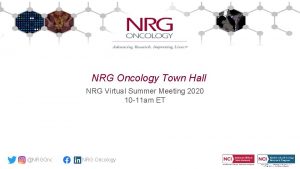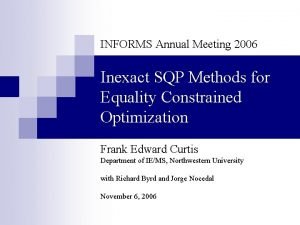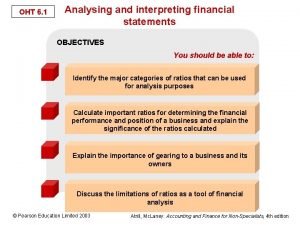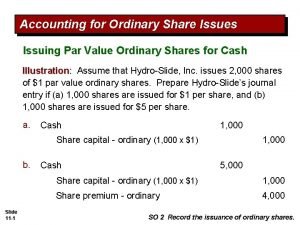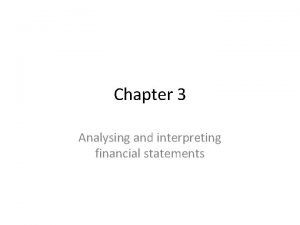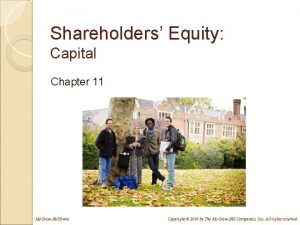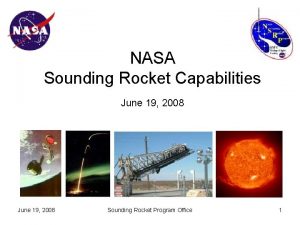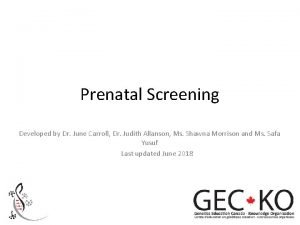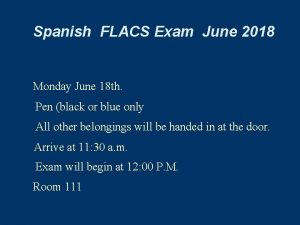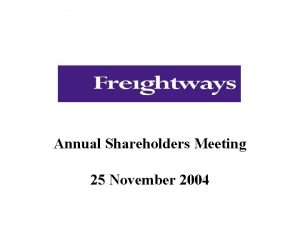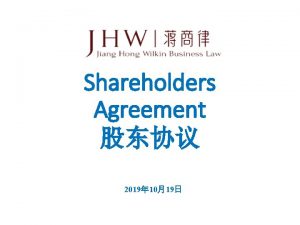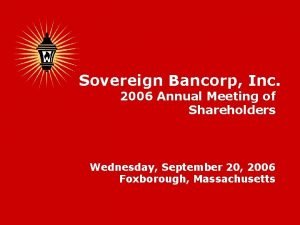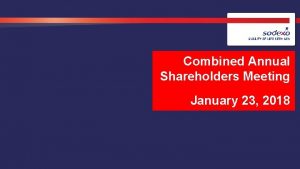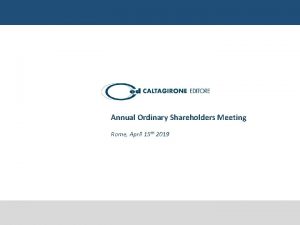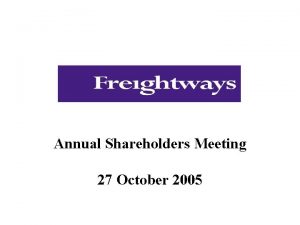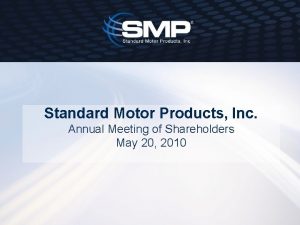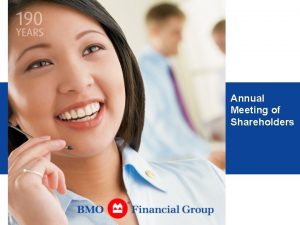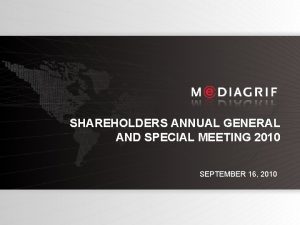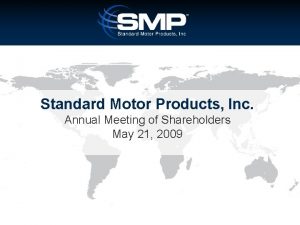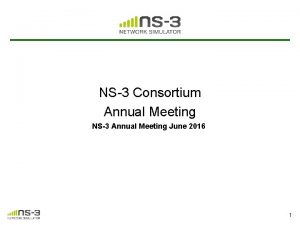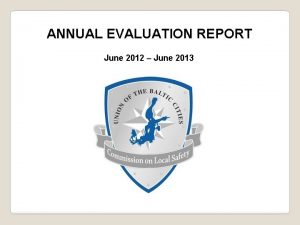Annual Meeting of Shareholders June 29 2004 Le



































- Slides: 35

Annual Meeting of Shareholders June 29, 2004

Le. Roy T. Carlson, Jr. President and Chief Executive Officer Telephone and Data Systems, Inc.

Safe Harbor Statement Under the Private Securities Litigation Reform Act of 1995: All information set forth in this news release, except historical and factual information, represents forward-looking statements. This includes all statements about the company’s plans, beliefs, estimates and expectations. These statements are based on current estimates and projections, which involve certain risks and uncertainties that could cause actual results to differ materially from those in the forward-looking statements. Important factors that may affect these forward-looking statements include, but are not limited to: changes in circumstances or events that may affect the ability of USM to start up the operations of the licensed areas involved in the AWE transaction completed in August 2003; the ability of USM to successfully manage and grow the operations of the Chicago MTA; changes in the overall economy; changes in competition in the markets in which TDS and USM operate; advances in telecommunications technology; changes brought about by the implementation of local number portability; changes in the telecommunications regulatory environment; changes in the value of investments, including variable prepaid forward contracts; changes in the capital markets that could adversely impact the availability, cost and terms of financing; an adverse change in the ratings afforded TDS and USM debt securities by nationally accredited ratings organizations; pending and future litigation; acquisitions/divestitures of properties and/or licenses; changes in customer growth rates, average service revenue per unit, churn rates, roaming rates and the mix of products and services offered in TDS and USM markets. Investors are encouraged to consider these and other risks and uncertainties that are discussed in documents filed by TDS with the SEC.

Economic and Industry Focus Economic recovery underway The telecommunications industry remains fastpaced and highly competitive • Wireless segment: • Intense competition from too many national carriers… … but consolidation appears on its way • Wireline segment: • Substitutive technologies – wireless, cable • Emerging technologies – VOIP, FTTP Consumers are driving the future of the industry

The Strategic Focus at TDS • Key to successful results - having the right strategy… and delivering on it • Both U. S. Cellular and TDS Telecom’s strategies support overall TDS mission: Providing outstanding communications services to our customers and meet the needs of our shareholders, our people and our communities.

U. S. Cellular Strategy • Differentiate with exceptional customer service • • • Network quality Broad distribution Dedicated people • Strategically strengthen regional footprint • Deploy CDMA 1 X technology in all markets • Enhance data service products

2003 Accomplishments • Provided exceptional customer service: • Admirably low churn • Converted dual billing system to U. S. Cellular’s own CARES billing and customer support system • Strengthened the footprint: • Exchanged wireless assets with AT&T Wireless • Announced sale of South Texas markets to AT&T Wireless; completed in Feb. 2004 • Launched 8 new markets • Continued deployment of CDMA 1 X • Launched easyedge. SM, advanced data services • Successfully managed wireless number portability

Post-pay Churn < 2% Six-year track record… and still strong

U. S. Cellular st -1 Qtr Highlights 1 st Qtr ‘ 04 Churn - postpay 1 st Qtr ‘ 03 1. 3% 1. 6% Net additions 196, 000 137, 000 Retail ARPU $40. 26 $37. 68 MOU 491 377

Technology Trends • Underlying philosophy: • Provide services customers want and value • Offer new technologies only when they: • can be fully supported • are based on strong business case • easyedge. SM • Launched new easyedge services • Continue to enhance easyedge offerings • EVDO • Currently trialing

U. S. Cellular - 2004 Focus Always driven by focus on delivering exceptional customer service, U. S. Cellular will: • Drive growth in its new and established markets • Continue to improve network coverage and service quality, completing several new markets build-outs • Complete deployment of CDMA 1 X • Continue to develop and enhance data-service offerings

TDS Telecom – Strategic Areas of Focus • Market Development • Market Fortification • Public Policy Advocacy • Productivity Improvement

Market Development • Aim to grow in clusters through potential combination of: • Acquisitions • Build-out variations • New technologies • Trialing Voice Over IP (VOIP) and Fiber to the Premise (FTTP)

Market Fortification • Proactively address substitution technologies by: • Developing new products and services • Enhancing existing services; increasing market share, penetration and profitability, particularly of high-speed data DSL service • Growing CLEC within its existing markets

Strategic Areas of Focus (cont. ) • Public Policy Advocacy • Champion TDS’s position to ensure favorable regulatory treatment • Productivity Improvement • Create efficiencies by optimizing crossfunctional processes

TDS Telecom - 1 st Qtr Highlights 1 st Qtr ‘ 04 1 st Qtr ‘ 03 ILEC Access line equivalents DSL Long-distance customers 722, 400 27, 300 266, 300 713, 800 12, 800 202, 100 CLEC Access line equivalents DSL 378, 800 22, 700 303, 900 13, 100

TDS Telecom - 2004 Focus • Lead the industry in customer satisfaction • Rapidly & profitably grow the CLEC operations • Rapidly grow DSL and other data services in both the ILEC and CLEC markets • Aggressively promote a positive regulatory environment for both ILEC & CLEC customers

Realizing TDS’s Mission • Requires sound strategies and people to execute them • Thanks to all who contribute to TDS’s success: • all employees and associates • the management teams • our customers • our vendors and partners • our shareholders • the boards of directors at TDS and USM We are committed to building on TDS’s strength


Sandra L. Helton Executive Vice President and Chief Financial Officer Telephone and Data Systems, Inc.

Safe Harbor Statement Under the Private Securities Litigation Reform Act of 1995: All information set forth in this news release, except historical and factual information, represents forward-looking statements. This includes all statements about the company’s plans, beliefs, estimates and expectations. These statements are based on current estimates and projections, which involve certain risks and uncertainties that could cause actual results to differ materially from those in the forward-looking statements. Important factors that may affect these forward-looking statements include, but are not limited to: changes in circumstances or events that may affect the ability of USM to start up the operations of the licensed areas involved in the AT&T Wireless transaction completed in August 2003; the ability of U. S. Cellular to successfully manage and grow the operations of the Chicago MTA; changes in the overall economy; changes in competition in the markets in which TDS and U. S. Cellular operate; advances in telecommunications technology; changes brought about by the implementation of local number portability; changes in the telecommunications regulatory environment; changes in the value of investments, including variable prepaid forward contracts; changes in the capital markets that could adversely impact the availability, cost and terms of financing; an adverse change in the ratings afforded TDS and U. S. Cellular debt securities by nationally accredited ratings organizations; pending and future litigation; acquisitions/divestitures of properties and/or licenses; changes in customer growth rates, average service revenue per unit, churn rates, roaming rates and the mix of products and services offered in TDS and U. S. Cellular markets. Investors are encouraged to consider these and other risks and uncertainties that are discussed in documents filed by TDS with the Securities and Exchange Commission.

Five-Year Results At 12/31/03 CAGR Revenues 13. 8% Operating Cash Flow 10. 5%

TDS 2003 Results Operating Revenues $3, 445. 2 M +15% Operating Cash Flow $964 M + 7% Capital Expenditures US Cellular TDS Telecom $633 M $139 M

1 st Quarter 2004 Results ($millions) Operating Revenues $870. 5 +7% Operating Cash Flow $228. 5 +10% Capital Expenditures U. S. Cellular TDS Telecom $100. 5 $ 24. 1

TDS Financial Strategies • Ultimate goal: generate profitable growth and build shareholder value • Four financial objectives toward that goal: • 10 -15% compound annual revenue growth rate over five years • Returning cost of capital in each business • Generate shareholder returns > comparable companies • Maintain A- investment-grade credit rating

Stock Repurchase 3 million share authorization: • 2003: repurchased 1, 960, 900 shares • avg price of $47. 10; total of $92. 4 M • 1 st Qtr ‘ 04: repurchased 40, 300 shares • avg price of $69. 82; total of $2. 8 M We plan to continue the program, given market conditions.

TDS Stock Price • 2003 TDS stock price: up 33% • S&P 500: +26% • Dow Jones: +25% • YTD 6/25/04: up 15% • S&P 500: + 2% • Dow Jones: - 1%

Debt Ratings. . . Investment Grade Moody’s Investment Service Standard & Poor’s Fitch TDS USM Baa 1 A- A- AA- TDS debt to capital at 3/31/04 36. 8% USM debt to capital at 3/31/04 30. 0%

Financing Initiatives Toward improving the company’s financial position, we: • Redeemed all $300 M TOPr. S • Redeemed $71 M high-interest notes • Refinanced U. S. Cellular short-term debt • Consolidated U. S. Cellular’s credit facilities

Sarbanes-Oxley Section 404… Focus on Fundamentals • SOX 404 – requires attestation to quality of company’s internal controls • TDS takes responsibility for the quality of our financial statements very seriously; always has • SOX 404 – while labor-intensive, does provide opportunity to refocus on the fundamentals • our ongoing aim: consistency, predictability and total reliability

2004 Focus • Strategic positioning • Performance to plan • Continued financial strength • Maintain A- credit rating • Maintain sufficient liquidity • Continue stock repurchase plan • Outstanding employees

TDS: Excellent Prospects • Full-service provider with strong, established wireless and wireline operations • Strong business units • Well-positioned in our markets • Proven business strategies focused on customer satisfaction, network quality and competitive product offerings. • Experienced management teams • Financially strong • Dedicated workforce of 10, 700 people • Supportive shareholder base

Annual Meeting of Shareholders June 29, 2004

Reconciliation of Additional Disclosures For year ended Dec. 31, 2003 and 2002 The Operating Cash Flow amounts in the tables presented above are not determined in accordance with accounting principles generally accepted in the United States of America ("U. S. GAAP"). Management uses Operating Cash Flow to evaluate the operating performance of its business, and it is a measure of performance used by some investors, security analysts and others to make informed investment decisions. Operating Cash Flow is used as an analytical indicator of income generated to service debt and fund capital expenditures. In addition, multiples of current or projected Operating Cash Flow are used to estimate current or prospective enterprise value. Operating Cash Flow does not give effect to cash used for debt service requirements, and thus does not reflect funds available for investment or other discretionary uses. Operating Cash Flow as presented herein may not be comparable to similarly titled measures reported by other companies.

Reconciliation of Additional Disclosures For the quarter ended March 31, 2004 The Operating Cash Flow amounts in the tables presented above are not determined in accordance with accounting principles generally accepted in the United States of America ("U. S. GAAP"). Management uses Operating Cash Flow to evaluate the operating performance of its business, and it is a measure of performance used by some investors, security analysts and others to make informed investment decisions. Operating Cash Flow is used as an analytical indicator of income generated to service debt and fund capital expenditures. In addition, multiples of current or projected Operating Cash Flow are used to estimate current or prospective enterprise value. Operating Cash Flow does not give effect to cash used for debt service requirements, and thus does not reflect funds available for investment or other discretionary uses. Operating Cash Flow as presented herein may not be comparable to similarly titled measures reported by other companies.
 Shareholders equity and shareholders funds
Shareholders equity and shareholders funds Aashto annual meeting 2015
Aashto annual meeting 2015 Aupha annual meeting
Aupha annual meeting Cwemf
Cwemf Scts membership
Scts membership American psychiatric association annual meeting 2020
American psychiatric association annual meeting 2020 How to run an annual general meeting
How to run an annual general meeting Nrg oncology semiannual meeting 2021
Nrg oncology semiannual meeting 2021 Grand lodge kentucky
Grand lodge kentucky Nrg oncology meeting 2018
Nrg oncology meeting 2018 Informs annual meeting
Informs annual meeting American epilepsy society annual meeting 2017
American epilepsy society annual meeting 2017 Positron vs proton
Positron vs proton Types of shareholders
Types of shareholders Avocet shareholders forum
Avocet shareholders forum Telesom shareholders
Telesom shareholders Types of shareholders
Types of shareholders Witwatersand basin
Witwatersand basin Stockholders vs shareholders
Stockholders vs shareholders Gearing ratio formula
Gearing ratio formula Return on ordinary shareholders equity formula
Return on ordinary shareholders equity formula Sales to capital ratio
Sales to capital ratio Chapter 11 shareholders rights
Chapter 11 shareholders rights What is meeting and types of meeting
What is meeting and types of meeting What is meeting and types of meeting
What is meeting and types of meeting For todays meeting
For todays meeting Today meeting or today's meeting
Today meeting or today's meeting Flacs exam
Flacs exam Nasa june 19 2008
Nasa june 19 2008 Head start of greater dallas
Head start of greater dallas Good morning welcome june
Good morning welcome june Confined placental mosaicism
Confined placental mosaicism Flacs exam
Flacs exam When your child leaves home poem
When your child leaves home poem What is the first sad memory of the young jose rizal
What is the first sad memory of the young jose rizal Elephant riding in phuket respuestas
Elephant riding in phuket respuestas







